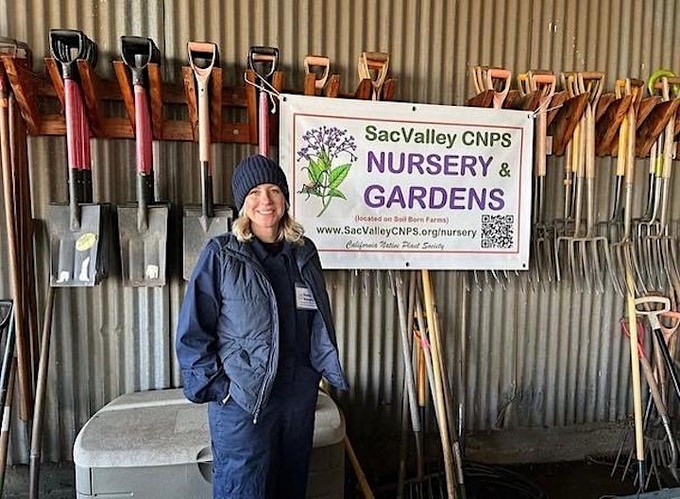
Hands-on workshop shows what to do with cuttings, divisions and seeds

Plant scientist Renee Murphy, here dressed for different weather than we currently enjoy, will lead the propagation workshop this Friday. Photo courtesy Renee Murphy
Learn how to propagate native plants during a hands-on workshop, set for 3 p.m. this Friday, Aug 18, in East Sacramento.
“Whether you dream of a flourishing garden or simply wish to expand your green thumb skills, this workshop promises to be an inspiring and informative experience for all plant enthusiasts,” say the organizers.
Plant scientist Renee Murphy, a.k.a. @midlifefarmgirl, will lead the two-hour session, billed as “Sacramento Native Plant Propagation Practice Workshop,” at McClaskey Adult Center, 5241 J St., Sacramento. Advance registration is required and space is limited. Get your ticket ($15 plus fees) via eventbrite: https://www.eventbrite.com/e/sacramento-native-plant-propagation-practice-workshop-tickets-691077420167.
“Whether you're a seasoned gardener or a complete beginner, this workshop is designed to help you gain confidence and expertise in the art of plant propagation,” Murphy said in her online class description. “During this interactive session, we will guide you through various propagation methods, providing step-by-step demonstrations and personalized assistance.”
Learn how to propagate plants via cuttings, root divisions or seeds. Also get tips on how to nurture those babies into mature plants.
“This workshop aims to foster a supportive and collaborative learning environment, allowing participants to share their experiences and learn from one another,” add the organizers.
Participants are asked to bring a pair of pruners or sharp garden scissors along with cuttings of any specific plants they’d like to practice propagating. Participants also may bring seeds to start and to share.
Comments
0 comments have been posted.Sacramento Digs Gardening to your inbox.
Food in My Back Yard Series
May 6: Maintain soil moisture with mulch for garden success
April 29: What's (already) wrong with my tomato plants?
April 22: Should you stock up on fertilizer? (Yes!)
April 15: Grow culinary herbs in containers
April 8: When to plant summer vegetables
April 1: Don't be fooled by these garden myths
March 25: Fertilizer tips: How to 'feed' your vegetables for healthy growth
March 18: Time to give vegetable seedlings some more space
March 11: Ways to win the fight against weeds
March 4: Potatoes from the garden
Feb. 25: Plant a fruit tree now -- for later
Feb. 18: How to squeeze more food into less space
Feb. 11: When to plant? Consider staggering your transplants
Feb. 4: Starting in seed starting
Sites We Like
Garden Checklist for week of May 4
Enjoy this spring weather – and get gardening!
* Plant, plant, plant! It’s prime planting season in the Sacramento area. Time to set out those tomato transplants along with peppers and eggplants. Pinch off any flowers on new transplants to make them concentrate on establishing roots instead of setting premature fruit.
* Direct-seed melons, cucumbers, summer squash, corn, radishes, pumpkins and annual herbs such as basil.
* Harvest cabbage, lettuce, peas and green onions.
* In the flower garden, direct-seed sunflowers, cosmos, salvia, zinnias, marigolds, celosia and asters. (You also can transplant seedlings for many of the same flowers.)
* Plant dahlia tubers. Other perennials to set out include verbena, coreopsis, coneflower and astilbe.
* Transplant petunias, marigolds and perennial flowers such as astilbe, columbine, coneflowers, coreopsis, dahlias, rudbeckia and verbena.
* Keep an eye out for slugs, snails, earwigs and aphids that want to dine on tender new growth.
* Feed summer bloomers with a balanced fertilizer.
* For continued bloom, cut off spent flowers on roses as well as other flowering plants.
* Add mulch to the garden to maintain moisture. Mulch also cuts down on weeds. But don’t let it mound around the stems or trunks of trees or shrubs. Leave about a 6-inch to 1-foot circle to avoid crown rot or other problems.